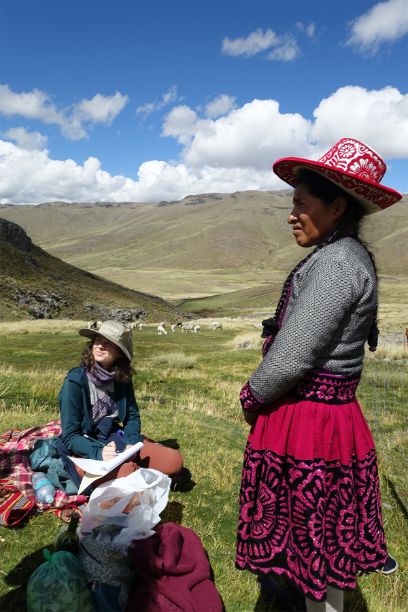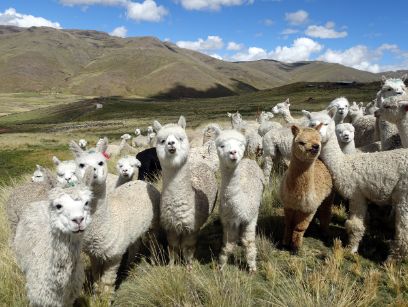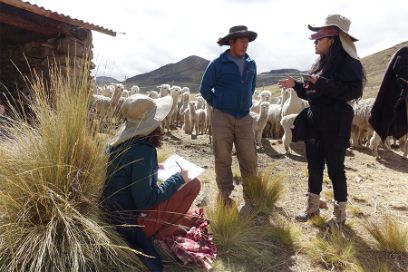- News
Researcher Diary: Interviewing alpaca farmers in the Andes
24.07.2025 The latest International Agriculture Researcher Diary comes from Annina Schweizer, a final-year BFH-HAFL BSc student currently in Peru.
As part of my six-month internship in Peru, I’m conducting research on the chemical composition of alpaca milk in collaboration with the Universidad Nacional Agraria La Molina (UNALM). Another part of my work is to collect qualitative data through interviews with alpaca farmers to better understand local production systems.
Here, I describe a memorable day in the Cusco region when I carried out my first field interviews with local producers at approximately 4500 metres above sea level.

Traditional welcome and interviews
We departed early in the morning with a small team: a local contact person from the village, a project colleague from UNALM and a driver. The road to the village was long, rough and only accessible by pickup truck. We walked the final leg because some farms aren’t accessible by car.
Upon arrival, before starting the interviews, we participated in a traditional ceremony. In the Andean worldview, it’s customary to offer a symbolic payment to nature (Pachamama) before beginning any type of work involving the land or animals. We buried coca leaves in the soil as a gesture of respect and gratitude.
Over the course of the day, I conducted six interviews with alpaca farmers, both men and women. The conversations took place in either Spanish or Quechua and were translated into English by my colleague. Each interview lasted around 40 minutes. Although some farmers were pressed for time and couldn’t engage longer, most were very open and curious. They welcomed us into their homes or onto their land, and I was touched by their hospitality and the pride they expressed when talking about their animals and their work.
The questions I asked focused on their alpaca husbandry systems, their daily routines, seasonal challenges, breeding and feeding practices, and the management of cria (baby alpacas). I was particularly interested in understanding how they adapt to the harsh climatic conditions of the high Andes and how they ensure animal health and productivity with limited infrastructure.

Knowledge exchange
One of the most striking impressions of the day was the contrast between the simplicity of life in the village and the complexity of the knowledge these farmers hold. Most families live in stone houses without running water or heating; fire is the only source of warmth. The nearest town is a two-hour drive away. Despite the remoteness, many of the farmers had completed basic schooling and had a good understanding of animal management, pasture rotation and even forage cultivation.
I was genuinely amazed by the biodiversity and agricultural creativity I witnessed at such high altitudes. The animals graze mainly on natural pastureland, often within fenced areas. In the evenings, they’re brought back to corrals close to the farmhouses. Farmers supplement their animals’ diets with cultivated feed – some grow oats, ryegrass or different clover species. Seeing these familiar crops from Switzerland thriving at 4000+ metres was fascinating and unexpected. It showed me how much can be achieved without relying on technology.

Visual impressions
Another powerful observation was the importance of the alpacas themselves. These animals are not just livestock: they’re a vital part of the families' lives – economically, culturally and emotionally. Many farmers referred to them with affection and a deep sense of responsibility.
Throughout the day, I took handwritten notes and photos of the animals, the grazing systems and the landscape – always with the farmers’ permission. For me, these visual impressions were just as memorable as our verbal interactions: the vivid colours of their traditional clothing, breathtaking mountain scenery and the modest but sturdy farmhouses told their own story.
The day made a lasting impression on me: it was both a professional milestone – my first series of interviews – and a personal eye-opener. Seeing how people live and work in such a remote and challenging environment reminded me how diverse agricultural systems can be, and how resourceful people are in adapting to their context. Despite the difficulties, there was a strong sense of purpose and identity in the community.
I now have a deeper understanding of the larger context of my research. I’m also more aware now that qualitative field research is not just about collecting data, but also about observing systems, building relationships, recognising local conditions, and treating people and places with respect.
Category: International